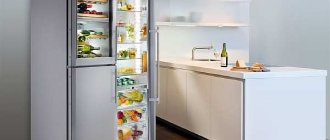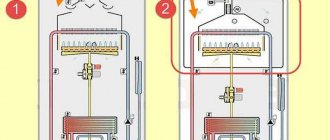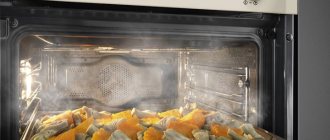Often, when buying a refrigerator for their home, most people are only interested in the appearance and price, and only then the power consumption of the refrigerator. As statistics show, a significant part of buyers make their choice in favor of a famous company, thereby justifying the huge costs of advertising. Many people don't realize that a cooling appliance's electricity use accounts for about 30% of monthly consumption. Every year, savings become more and more relevant, and when purchasing, it would be useful to pay attention to the power consumption in kilowatts (kW), because the refrigerator is constantly connected to the network and consumes electricity 24 hours a day, 365 days a year.
The characteristics of the device are indicated in the instructions for the refrigerator, but if you do not have it at hand, they can be found on the information sticker located on the back wall or inside the refrigerator compartment. The average power is in the range from 100 to 200 watts per hour, this power is enough to maintain a temperature of -5°C in an environment of +25°C.
Main parameters on which energy consumption depends
The main part of the refrigerator is the compressor (its motor). This device compresses and pumps refrigerant vapor, thereby cooling the surrounding area. The average efficiency and energy consumption of a refrigerator directly depend on factors such as:
- There are 2 compressors in the system.
- Refrigerator volume.
- Temperature in the room where the household appliance is used (the higher the temperature, the more energy is needed to maintain the temperature in the chamber)
- Availability of the No Frost system (dry freezing).
- Ice maker function.
- Set temperature settings inside the chambers.
- The tightness of the refrigerating chamber.
- Door opening frequency.
You also need to take into account the number of family members and the average weight of food that the device will cool per day.
Volume
The dimensions of the refrigerator play a major role in its selection. It is difficult to place a large unit in a small room. Therefore, the first thing people pay attention to is the volume, that is, the size of the device.
The buyer must consider the number of cameras. Single-chamber ones are purchased for a small kitchen. It has a freezer built into the common compartment. They are small in size, economical, and easily integrated into furniture.
The most popular are two-chamber ones. They are divided into a freezer compartment with a temperature of – 18 0C and a cooling compartment, where the temperature is maintained at +2 +7 degrees Celsius.
Refrigerators have different sizes, from medium to large, the height of which exceeds 2 m. The industry produces three-door units. But these are piece goods, usually ordered from catalogs.
When buying a refrigerator, take into account that units with increased volume consume more electricity.
Choosing a refrigerator by energy consumption class
In household appliance stores, many of us paid attention to energy efficiency stickers in the form of Latin characters from A to G. Recently, we have seen the labels A and A+ or A+++. These designations mark more advanced models from their predecessors. So, for example, a device with energy consumption class D consumes 100%, and class A will consume 55% less energy, type A+ by 65%, type A++ will consume 85-90% less energy and A+++ up to 100% less electricity. These data are conditional, since a small Class A appliance will consume much less energy than an industrial refrigerator with a No Frost A+++ system.
Some indicators
The variety of products from this company is very diverse, which allows you to choose them to solve many problems. There are several types of Atlant refrigerators that differ in their specific characteristics:
- XM 4425-009 ND. This model of refrigeration design is one of the most powerful. The product consumes about 415 kW/year. This is due to the fact that it is equipped with a special No Frost system, which requires a significant amount of electricity.
- XM 4426-009 ND . This system is also equipped with a special No Frost functionality, which leads to its consumption of about 408 kW/year. The product is distinguished by a large refrigerator compartment with a volume of 247 liters.
- ХМ4024-000. Drip type refrigerator. The rated annual power of the device reaches 364 kW/year. A distinctive feature is the low noise level, not exceeding 39 dB.
- XM 6221-000. This modification belongs to the A+ energy consumption class, while all previously discussed systems belong to the A-class segment. This refrigerator is relatively economical and consumes about 308 kW/year with a total volume of two chambers of 348 liters and a freezing capacity of up to 15 kg/day.
Atlant refrigerators are distinguished by practicality and high-quality technical indicators that meet modern standards. The variety of models allows you to choose them not only with optimal power values, but also with powerful and reliable functionality.
Source
What function is affected by the power of the refrigerator?
The power of a refrigeration unit directly affects its energy efficiency and also affects the operation of its additional functions.
Energy efficiency is determined by the rational use of electricity by a device. Thus, a class A refrigerator consumes an average of 100 watts per hour, 1.5 kW per day, and over the course of a year this figure can vary between 365-550 kW. What consumption you reach depends on how correctly the owner uses his refrigerator.
Freezing power is an indicator that determines how much food (in kg) the freezer is able to freeze in one day.
The information sticker contains information with the indicator “X***”. The number of stars next to the symbol depends on the amount of food being frozen. The freezing power rating is measured in kilograms per day and indicates the amount of food (in kg) that it can cool to a temperature of -18°C in 24 hours. The default room temperature of food is +18-20°C. For ordinary household refrigerators, when used in a single-family home (of 3-4 people), the freezing capacity should not be lower than 9 kg/day.
An example of refrigerator brands with different food freezing productivity:
- Atlant - on average 20-21 kg per 24 hours;
- Samsung - up to 18 kg in 24 hours;
- LG - from 15 to 17 kg per day;
- Hotpoint-Ariston - about 18 kg in 24 hours.
All of the above information will help you choose the most suitable refrigerator option, depending on the purpose of use, electricity consumption and freezing speed. You may also find information about the most reliable refrigerators useful.
Source: Tehnika.expert
Review of the best options
Basically, two-chamber models equipped with an autonomous freezer are produced under the Indesit brand. The location of the freezer can be either top or bottom. The differences, as a rule, are in the dimensions of the case and the capacity of the compartments.
For small kitchens and hotels, the company produces minibars for drinks and food. The height of such miniature cabinets does not exceed 85 cm. They may have a small freezer compartment, which is located in a common building.
All Indesit refrigerators are divided into three main types:
- from the Evolution series;
- with 2 doors - Forma New;
- combined options Forma New.
We offer you to compare some popular models below.
SB 167
A model with a bottom freezer compartment equipped with an electromechanical control type. There is only one compressor. Energy efficiency class - B. Isobutane gas (grade R600a) is used as a refrigerant. The design has 2 compartments and 2 doors. The dimensions of the case in width, depth and height are 60x62x167 cm, respectively.
The freezer is defrosted manually, and the main compartment has a drip system. Operating time in autonomous mode (cold storage) is up to 15 hours. The maximum freezing capacity is up to 4 kg of food per day. When disconnected from the network, the indicator light turns on.
Important! The total volume is 278 liters. At the same time, the displacement of the main compartment is 193, the freezer compartment is 85 liters.
The shelves are made of glass. Additionally, it is possible to hang the door on the other side. Operation noise - up to 39 dB. The refrigerator belongs to climate class N (read more about the characteristics in the review “Climate classes of the refrigerator”). Weight - 60.5 kg.
How much does this refrigerator cost? According to the YandexMarket resource as of October 20017, the price starts from 14,000 rubles.
User reviews
A pleasant bonus was not only the price, but also the drip defrosting of the main chamber. Automatic defrosting of the freezer would be nice, but what is not there is not there. To be honest, 6 (.) years passed from the moment of purchase to the first defrosting of the freezer. During this time, the compartment operated in one mode without failures, melted or frozen products. There was one repair, after which I moved the refrigerator to another corner of the kitchen, it began to make noise - the master advised me to level the position and tighten the legs. In general, it has been working for the 7th year, with one call to the master - this is excellent for the money.
Absolutely quiet operation! It cools quite well and takes out a little light. After our family grew by 2 people, we realized that it was too small for us, we gave it to our parents at the dacha, and bought a new one for ourselves. I read the reviews (as befits a Russian person - after the purchase, now I have become smarter), many write that “Indesites” are terrible. Maybe we were just unlucky and got a defect, but for us everything was fine - 4 years of uninterrupted operation.
It’s very convenient that the freezer is at the bottom - I look there less often, which means I don’t have to bend over again. The freezer doesn't freeze, no ice, everything is great. It is slightly noisy during operation, I called a repairman and said that it should be like this, like it’s not a breakdown. Energy consumption class B, this is a little disappointing, but now there are more efficient ones. The quality of the assembly, shelves, containers - everything is fine.
DF 5200 W
Another model with a bottom freezer, but with an electronic control device. Energy efficiency class - A. Chambers - 2, motor-compressor - 1. Housing dimensions (WxDxH): 60x64x200 cm.
No Frost is provided in the freezer and main compartment (note: read the review “How to defrost a No Frost refrigerator”).
- stores cold in autonomous mode for up to 13 hours;
- freezing capacity is 2 kg per day;
- when the door is not closed, a sound signal sounds;
- there is super cooling and super freezing;
- You can find out how many degrees are inside the case on the display.
On a note! The total volume is 328 liters, of which 253 are in the main compartment and 75 in the freezer.
The door can be hung on the other side. Noise - up to 41 dB. Climate classes correspond to N and ST. Equipment weight - 67.6 kg.
Types of freezers and their capacity
The following types of equipment are on sale:
- lari;
- showcases, etc.
The equipment differs in energy consumption classes from economical (A) to EG. Modern devices provide improved characteristics of subclasses for A+, A++.
Devices with different defrosting systems differ in the amount of electricity consumed:
- A standard manual defrosting system does not require much electrical energy. However, the efficiency of the devices is lower than modern ones, and additional costs are also required to maintain the devices in good condition.
- The No Frost technical solution provides for an increase in the standard electrical energy consumption due to the fan built into the design. The devices use modern technologies and improved thermal insulation materials.
How much electricity the freezing equipment will consume depends on the volume of the devices and the quality of the assembly.
Cabinets
Freezers are similar to standard refrigerators and contain sections separated by plastic partitions. Plastic elements help prevent the spread of odors. Many products are equipped with a No Frost system, which ensures comfortable operation and the absence of ice on the walls.
Freezers are compact and do not take up much space in the kitchen. Structures for freezing food are placed vertically. The height of the devices is 65-200 cm. The width of the devices for freezing products reaches 45-66 cm, the depth of the equipment is about 60-68 cm.
Freezing appliances are divided into built-in models and appliances installed separately. Built-in products can be mounted into pieces of furniture in the room.
Chest
Chest freezers are used in apartments, houses, and trading floors. Chest freezers differ from standard freezers in their larger capacity. Products are placed on trays in special departments.
Many devices are not equipped with a No Frost system, so frost often remains on the walls during product operation.
Appliances need to be defrosted regularly. The designs of freezing equipment are presented in the form of boxes located horizontally. The door is the lid on top. Chests are provided for placing large-sized products, because... gratings are not used.
Showcase
Freezer display cases are used in stores to present products to customers. The freezer has a small capacity and is designed for storing meat and dairy products that do not require freezing. The top cover is often transparent to display products. In some cases, devices are equipped with sliding glass doors. For safe operation, low-emission glass is used to equip the structure.
Classification of energy consumption systems
Energy consumption systems are classified taking into account the consumption of kilowatts per month, the classes are distinguished by letter codes (AG), as well as improved models with class A++ indicators. Electricity consumption is reduced due to the use of additional thermal insulation materials. How much kWh the equipment consumes per hour also depends on the cooling system.
Standard cabinet-style freezers use about 190 watts per hour. The total consumption of electricity is observed in equipment with the No Frost system due to the increased load on the compressor and intensive operation of the fans. The consumption of electrical energy in chest freezers for 1 hour is 80 watts.
Source: oholodilnike.ru
We count electricity
The average electricity consumption of a refrigerator ranges from 300 to 380 kilowatts per year. But there are also more economical models where annual consumption ranges from 230 to 300 kW per year. There are also powerful refrigerators that consume from 400 to 600 kilowatts per year.
Read
How much energy do water heaters consume?
To calculate electricity costs, we will take the average energy consumption of modern refrigerators. Then we get the following electricity consumption at different time intervals:
- in 1 year the refrigerator will spend 340 kilowatts or 340,000 watts
- For 1 month, expenses will be 340/12 months = 28.3 kW
- In 1 day, the refrigerator will consume 0.8-0.9 kW of electricity
- for 1 hour - 33.3 watt ~ 0.033 kW
Let's calculate how much it will cost in rubles if the cost for 1 kilowatt is 4 rubles.
- for 1 year - 1360 rubles
- for 1 month - 113 rub. 33 kopecks
- for 1 day - 3 rubles. 77 kop.
- for 1 hour - 16 kopecks.
We provided all the calculations as approximate ones, since we were based on the theoretical data specified in the technical specifications; the values may differ from yours, but not by much. In general, this will depend on how often the refrigerator door is opened and the amount of food being cooled.
In the following articles we will look at how much electricity other devices, such as a TV, washing machine or computer, consume. Stay with us. And now a couple of tips on how to save on electricity.
Power of household refrigeration units and what it depends on
The power consumption of a refrigerator is the total amount of electrical energy it consumes during operation. This electrical appliance consists of other devices that also consume energy: compressors (one or more), heaters, fans.
The parameter under consideration consists of:
- capacities of the above devices, external dimensions of the refrigerator;
- thermal insulation of the seal;
- the presence of additional functions and the presence of the No Frost system;
- quantity and temperature of food placed in the refrigerator;
- operating conditions and time of year.
There is an average power of the refrigerator, which is stated in the instructions. Its size in most cases does not exceed 250 W. Along with this power, you may come across the actual power of the refrigerator. It is capable of reaching 500 watts. The most significant share of energy consumption is determined by the power of the refrigerator compressor.
How is the power of a refrigerator measured? Of course, in units of power well known in physics - in watts (W). In order to determine the average power of an electrical appliance, it is necessary to determine how much electricity in kilowatts the unit consumes per day.
To find out by measuring how much power a refrigerator has, you can use a device called a multimeter. This measuring device measures the refrigerator circuit while the compressor is running. The values you receive must be multiplied by the mains voltage equal to 220 volts. Although it is necessary to take into account that when the compressor starts, a current will flow through the circuit, which is 2-3 times higher than the rated voltage. In view of this, the obtained readings will require multiplication by 3.
A special sticker, which is often located on the outer wall (sometimes in the chamber) of the electrical appliance, should inform you about the power consumption of the refrigerator. You can find the same data in the instruction manual that came with your household appliance.
In the above manual, as a rule, the maximum power is indicated (it is fixed at the moment the compressor is turned on) and the power of the refrigerator, which is called the rated average. The standard values for these powers are as follows: 0.3 kW per hour for maximum and from 0.1 to 0.2 kW per hour for average nominal. The use of the concept of maximum power consumption is due to the fact that the compressor operates intermittently. This happens only after special sensors signal a change in temperature.
Using Power Meter
Now let’s take a closer look at the features of the Power Meter device, which allows you to measure many useful parameters: current strength, voltage, power consumption and others.
The device runs on a built-in battery. Before you start using it, you need to go into the settings and set the price for your region.
To do this, hold down the Cost button and set the current parameter.
To change a characteristic, use the UP key, and to move to the next function, use the Function key.
For a couple of weeks of operation of the refrigerator, the device showed that the device generated 51 rubles, 14 kW (for 4 days out of 7).
Also in the menu you can see the minimum and maximum Watt consumption (up to 1 kW).
During operation, the device consumes 150 W, and together with the light bulb - 164 W.
How much does the refrigerator consume? Power Meter will help. Review and tests
Efficiency class
The efficiency class is usually understood as a conditional indicator that characterizes the electrical energy consumption of a refrigerator. To designate this class, capital Latin letters were adopted: starting from A and ending with G. The following three classes have recently been added to the old 7 classes (A+++, A++ and A+). The efficiency of these classes is higher than A. Thus, the power of a refrigerator in kW hours per year for the LG brand, which belongs to class A, is 350-360 kW per year.
The values given for these letters determine the average power consumption of the refrigerator. This so-called average power consumption of a refrigerator for a class D refrigeration unit is taken as 100%. Relative to this class, the energy consumption values, measured in kWh, for class A are 55% less, for A+ by 65, A++ - 85 and A+++ - 95%. For convenience, refrigerator manufacturers highlight all the classes under consideration in color. The differences between classes in the electrical energy they consume are significant.
The video describes the efficiency classes of modern refrigerators: from A+++ to D in order of decreasing efficiency. It is also said that the stationary cooling system is more economical compared to No Frost.
Source: sovetexpert.ru
Peculiarities
A refrigerator consists of many electrical systems that are responsible for the specific characteristics and functionality of the device.
All of them are connected to the power supply using special mechanisms. Their power consumption is measured in watts and depends on several basic parameters:
- Compressor type. Modern refrigeration units are equipped with one or two similar mechanisms. The more compressors, the higher the energy consumption. This characteristic depends directly on the power of the system itself, which drives the refrigerant inside the tubes.
Energy
Many may think that this is something from the field of scientific work in physics, but in practice everything is much simpler. And in the end we have staggering figures for paying for electricity. And so, let’s take a closer look at what the power consumption of a refrigerator is, and calculate the average power indicator of the device.
The refrigerator is a complex electrical circuit, there are turbochargers, light bulbs, cooling fans and systems for heating the internal parts. All these mechanisms require electricity to run. And the total amount of this same energy is called power used. It is measured in kilowatts (kW). To calculate how energy-consuming a device is, we need to know the average indicator; it will be equal to the value of the energy spent by the unit in one day.
How to determine
What power a refrigerator has is usually stated in the instructions for using the device. This indicator is also indicated on an information plate glued to the back of the refrigerator or inside the refrigerator, which is much less common. The average power of a refrigeration unit usually ranges from one hundred to two hundred watts per hour, these indicators are enough to maintain an internal temperature of -5 degrees Celsius with an external temperature of about plus twenty-five. The most energy-consuming element in a refrigerator is the compressor. The amount of energy spent is affected not only by the compressor, but also by other factors. With the same indicators, different instances can use energy differently. Let's figure out what affects the amount of energy consumed:
- A two-compressor unit will consume more electricity than a single compressor unit, and you should also not lose sight of the compressor power;
- Availability of a no Frost system or other new systems;
- The volume of the refrigerator's internal chamber directly affects the amount of energy used;
- The higher the temperature of the room where the device is located, the more power is needed for cooling and vice versa;
- Sealing the unit;
- Filling level of the refrigerator compartment: the more dishes, the more energy is needed to maintain the optimal temperature.
Electricity consumption calculations
The values of consumed electricity depend on the number of refrigeration chambers (the more chambers, the more electricity is required to cool them), on the cooling system (compressor, absorption, thermoelectric, gas) and other characteristics.
Compressor refrigerator calculations
The minimum average power of a compressor refrigerator ranges from 100 to 200 W/hour, and 300 W/hour is the maximum, that is, the average is about 250 W/hour.
In 1 minute the refrigerator consumes 4.17 W : (250 W / 60 minutes). This is under normal conditions, the temperature in the refrigerator compartment should not fall below +5°C, and the temperature in the room should not exceed +25°C.
But since the refrigerator does not work all day, but only when the temperature drops, in about a day the device consumes a minimum of 1.5 kW, a maximum of 3.5 kW, and an average value of 2.5 kW per day.
This comes out to 75 kW per month: 2.5 (consumption per day) * 30 (days in a month).
Depending on the region, electricity tariffs may differ, so we take an approximate value of 3.75 rubles. for 1 kW/hour, multiplied by monthly consumption: 3.75*75=281.25 rub.
Based on calculations, for using a refrigerator with a power of 250 W per month you will need to pay 281.25 rubles.
For absorption refrigerator
The normal minimum power is 75 W, and the maximum is 200 W, with an average value of 135 W/hour.
Consumption in 1 minute: 135/60=2.25 W.
Approximately 0.85-1.5 kW per day comes out, we take 1.2 kW per day.
Consumption per month: 1.2*30=36 kW.
Payment amount: 36*3.75=135 rub.
Car refrigerators
Also, car refrigerators have recently gained great popularity. They are small in size and have low power, which makes them possible to use during trips and travel.
The average power of such a refrigerator is 45 W/hour.
For one minute of operation, the power consumption is 0.75 W: 45/60 minutes.
During the day it consumes about 360 W.
This comes out to 10.8 kW per month: 360*30 = 10800 W.
Payment amount: 10.8 * 3.75 (for example, the tariff for 1 kW/hour, there are different tariffs in each region, district, city and village) = 40.5 rubles.
Due to their small volume and good thermal insulation, they consume little electricity, but they are not suitable for home use due to their small capacity.
All they need is a connection to a car battery to maintain the cold inside the chamber.
Important! These calculations are made based on average statistical data and depending on the manufacturer’s model and the power consumption of the refrigerator, these values may vary.
Differences in energy consumption
You come to the store, there are many different models in front of you. Special markings will help determine which of them will save energy. It represents the special characters of the English alphabet from A to G or A+, A++ and A+++. The latter are installed on new models, which in terms of technical characteristics significantly surpass their older brothers. All the values that these letters represent determine the average power of the refrigerator. The value of class D refrigerators is taken as 100%, class A will spend 55% less energy, A+ 65% less, A++ 85%, A+++ 95% less.
The presented data is quite arbitrary, since a small class A appliance will be much more economical than a large refrigerator with a class A+++ no Frost system.
In order to calculate how much your specific refrigerator consumes, we take the data from the sticker, which says the daily and annual kWh, and then average it. The error may depend on several factors:
- The room temperature should be between 24 and 27 degrees Celsius;
- Average workload;
- Average door opening cycle.
Freezing
Today, the number of refrigeration chambers is so large, and the number of functions and characteristics is growing at lightning speed. So when choosing a white friend, you should also pay attention to a performance indicator called freezing power. This indicator is also displayed on the information sticker and in the instructions, marked with the abbreviation “X***”. Measured in kilograms per day, this indicator shows how many kg of food it can completely cool to -18o C in twenty-four hours, provided that the initial temperature of the food is room temperature. For an ordinary family of four people, a refrigerator with a freezing capacity of 10 kg/day will be quite sufficient.
Here is an example of refrigerators that differ in freezing productivity:
- Atlant about 21 kg for 24 hours;
- Samsung up to 18 kg in 24 hours;
- LG up to 17 kg in 24 hours;
- Indesit about 30 kg per day;
- Biryusa - up to 21 kg/day;
- Ardo up to 33 kg per day;
- Hotpoint-Ariston up to 18 kg per day;
- Siemens about 25 kg in 24 hours;
- Bosh about 22 kg in 24 hours.
Let's sum it up
We hope that the information has fully disclosed the concept of power consumption of a refrigeration unit. Now, when buying a new white friend, you can easily calculate the power consumption of the refrigerator and freezing compressor, and choose the best option for yourself.
Source: tehnika.vyborkuhni.ru
Main energy consumption classes
Back in the 90s, all modern household appliances began to be divided according to the newly introduced energy consumption classification. This equally applies to both miniature light sources and large water heating tanks and washing units.
Now labeling indicating the class inherent in a particular device is mandatory.
On average, annual electricity consumption in kilowatt-hours is in the range of 235-465 kW. Knowing the parameter, calculating the approximate daily or monthly figures is not difficult.
To do this, it is enough to divide the declared value by the number of days/months in a year - 365/12. For example, if a device consumes 230 kW/h annually, then the daily rate is approximately 0.63 kW/h. Monthly calculations are carried out using a similar principle.
letters ranging from A to G. Each of them is assigned a color graphic indicator for a more understandable perception. Some designations are supplemented with the index “+” .
The gradation is determined by dividing the actual amount of consumption by the standard indicator. The first figure is established during experiments.
The second is obtained as a result of calculations using a complex formula, which involves many components - volumes of departments, temperature, technologies used, climate class, etc. Information is provided to the user in the form of a percentage of energy consumed for a specific time period to specified standards.
The ABC of energy consumption of refrigerators looks like this:
- A+++ – up to 22%;
- A++ – 22-33%;
- A+ – 33-42%;
- A – 42-55%;
- B – 55-75%;
- C – 75-95%.
The most economical and rational equipment is considered to be category A with a green indicator of different shades, the most expensive is G , marked in red. Units A+ , A++ , A+++ consume three times less than generally accepted standards.
Devices below class C are practically no longer produced, as they are malicious wasters of light. The energy consumption of such refrigerators is from 110 to 150% . These values are far from the norm and can cost a pretty penny.
in terms of energy consumption includes equipment marked B and C. It saves approximately 15 to 35% of resources.
The difference between refrigerators classified into different classification categories can be quite significant. A type A++ requires only 143 kWh per year, while its fellow G consumes more than 900 kWh over the same period.
A+++ , which are 50% more economical than even equipment that has an A+ , will help you save your family budget . It is quite natural that they cost an order of magnitude higher, but the subsequent savings will soon pay for the investment in the purchase with interest.
Rules for choosing an economical refrigerator
Despite all the markings and miscalculations, the fact that how much electricity the purchased refrigerator will consume is influenced by a lot of circumstances.
Some of them are hidden in the design and configuration, others depend directly on the user and on how favorable conditions he creates for the operation of the equipment.
The number of kilowatts consumed by a refrigerator per day, month or year is not calculated based solely on data from the technical passport. The parameters are also influenced by the filling that the manufacturer supplies its development with.
If you want to find the most economical device, you should first consider the following nuances:
- number and type of compressors;
- cooling system;
- chamber volume;
- tightness and thermal insulation;
- set of functionality.
Compressor. The range includes one- and two-compressor models of refrigeration units.
As a rule, versions with two motors are more convenient to use, since they provide more options for effective temperature control and defrosting.
When choosing equipment, you need to pay attention not only to the number, but also to the type of compressors. In terms of energy consumption, inverter models win by a significant margin. The operating mode of the inverter is different in that it instantly raises the temperature to the set values and constantly maintains it, smoothly changing the power.
A conventional compressor takes longer to reach the required levels, turns on at full power, and then turns off. As soon as the sensor detects temperature changes, the thermostat starts the mechanism again. This adjustment technique is called stepwise. In terms of saving electricity, it is imperfect.
Cooling system. Modern refrigeration units are equipped with two main cooling systems - drip or NoFrost . In devices with a drip system, the evaporator, which maintains a cold temperature, is located on the rear wall. Over time, the formed pieces of ice flow down in drops into the pan, where they evaporate.
The innovative NoFrost technology involves dry freezing, in which frost does not appear and ice does not freeze. The evaporator is built above the freezer compartment or behind the back of the unit. Products are frozen by blowing cold air, which is provided by fans.
Once every few hours the fan stops, at this time the heating component is turned on, the melted liquid is transferred through special grooves into the pan and evaporates. Such refrigerators do not require defrosting.
“no frost” system includes several subtypes - Full No Frost , Total No Frost . There is also combined cooling, combining two main types. In terms of energy consumption, the traditional cooling system is more economical.
Due to the presence of additional fans and a powerful heater, NoFrost technology is more demanding on energy resources.
Number and size of cameras. As for the number of compartments, the best option for the consumer is two-chamber models. Single-chamber counterparts are not so “gluttonous”, but they are usually installed only in those rooms where space does not allow them to accommodate impressive dimensions.
The energy consumption index is also affected by the volume of refrigeration equipment: the larger it is, the more noticeable the consumption.
Tightness. Before purchasing a refrigerator, you need to check the quality of the seals and thermal insulation configurations of the body. Their lack of reliability is dangerous due to excessive loss of cooled air, which provokes an increased load on the compressor and, accordingly, increases energy costs.
Even the color of the product is reflected in the kilowatts consumed. It has been established that silver material has lower emissivity and releases heat more slowly.
Frequent breakdowns
The manufacturer of household appliances Indesit has recently been introducing the latest technologies into its designs. The diagram of the simplest household unit from Indesit is shown in the photo:
Despite the high precision of settings and annual improvements in build quality, like any electrical appliances, Indesit refrigerators are prone to breakdowns. Most often the following problems happen to them:
- Freon leakage from the circuit (due to corrosion processes).
- Compressor motor failure.
- Sensors (thermal relays) fail.
- The seal wears out quickly, causing the door to stop closing tightly, ice growing on the walls of the chambers, and the compressor working to wear out.
- Blockage of the capillary pipeline (tubes through which freon gas circulates).
- In devices with electronics, the electrical circuit may burn out. Sometimes the control board requires adjustment or firmware, but cases with a complete replacement of the module are not excluded.
It’s up to you to decide whether to buy an Indesit refrigerator or not. Now you have all the information about the advantages and disadvantages of devices, you are familiar with representatives of the model range and user reviews. We wish you a successful purchase and long-term operation of the equipment!
Source
The influence of external factors on energy consumption
To achieve high-quality operation in the maximum possible economy mode, any refrigerator must provide the necessary conditions. Manufacturers indicate most of them in the instructions that come with the product.
In general, energy consumption will depend on:
- air temperature in the room where the device is installed;
- the degree of food load in the working chambers;
- door closing/opening frequencies;
- timely defrosting.
Ambient temperature is one of the leading criteria. In the process of research and scientific experiments, it has been proven that refrigerators operating in rooms where average readings of 16-17 degrees Celsius are recorded save the budget by approximately 1.5 times.
This does not mean that the equipment can be installed in critically cold environments. Under such conditions, the compressor simply will not turn on or, worse, will fail altogether.
Loading of cameras . Before filling the refrigerator with food, you should study the technical parameters and manufacturer’s recommendations in this regard. You should never load it to capacity.
It is also worth distributing provisions evenly across shelves and departments, otherwise air circulation will be difficult, which is also not the least important for energy consumption.
Defrosting . If the refrigerator is not equipped with an automatic system, do not forget about regular self-defrosting.
Exploitation . If the unit door is opened frequently, the load on the motor immediately increases. This is due to the fact that the cooled air accumulated inside quickly escapes outside. Accordingly, to make up for losses, the device begins to work at maximum power, increasing electricity costs.
Comparison with other household appliances
It is believed that large household appliances consume more electricity than small ones. But it is not always the case. Energy consumption depends on the power of the device and its operating time.
If we compare average values, refrigeration equipment with a high energy saving class will be more economical than many other kitchen units. For example, a standard 2 kW electric kettle uses about 28 kWh monthly. A class A refrigerator is about 19 kWh. If you use a computer 3-4 hours a day, then up to 60 kWh will be used up in a month. The consumption of a washing machine will be approximately the same.
TOP 5 economical refrigeration units
Having set the goal of purchasing the most economical model, you should study in more detail the offers of leading manufacturers. The range of refrigeration equipment is rich and choosing the best option that meets your needs is not difficult.
We invite you to familiarize yourself with 5 economical units from the best manufacturers.
Model #1 - Liebherr CBN 4815
The CBN 4815 unit of the Liebherr brand has a high price, averaging 72 thousand rubles, but also the most economical consumption category at the moment - A +++.
Despite such modest needs, the manufacturer managed to combine many innovative developments in the unit. It provides convenient flexible temperature settings using a touch screen, a super freezing option, and a built-in activated carbon filter that purifies the air from bacteria and contaminants.
The doors are protected with a reliable, replaceable seal that matches the color of the body. The only drawback of the modification stems precisely from the main advantage - efficiency.
We are talking about the low power of the compressor, which takes a long time to produce cold when turned on. It takes about a day for it to enter normal operating mode, despite the fact that most modern and Soviet refrigerators reach the desired temperature within 10-30 minutes.
The following video demonstrating the main capabilities of the model and the layout of the internal space of the working chambers will help you form your opinion about the CBN 4815:
In the wide range of Liebherr products, in addition to the refrigerator we presented, there are a number of excellent models. They have earned the recognition of both owners and repairmen, who rarely have to restore their functionality. Our rating of refrigerators will help you choose the best option.
Model #2 – LG GA B489 YEQZ
The spacious and tall GA B489 YEQZ equipment from the LG brand, A++ class equipment, is cheaper than the previous model. The cost of this model starts from 51 thousand rubles.
Energy consumption indicators are 237 kW/h per year, 20 kW/h per month, 0.65 kW/h per day. The unit operates on an economical and relatively quiet inverter compressor. It comes with a ten-year warranty period.
No Frost applies to both compartments, so the freezer compartment does not need to be defrosted manually. Each compartment has LED lighting.
A special feature of the model is the unusual structure of the lid of the block for vegetables/fruits. It has cells that trap condensation, preventing drops from falling on the food.
Thus, the optimal humidity necessary to preserve the taste and beneficial properties is maintained.
In addition to the model we have described, the range offered to consumers includes a number of interesting offers; the article we recommend will introduce you to the best LG refrigerators.
Model #3 - Bosch KIS87AF30
Built-in appliances made in Germany, distinguished by their interesting design and compact dimensions, are an ideal solution for cramped kitchen spaces.
The Bosch KIS87AF30 refrigerator is characterized by class A++, in which it consumes 226 kW/h per year, 19 kW/h per month, 0.62 kW/h per day. Its cost averages 49 thousand rubles.
The equipment is controlled through an electronic sensor unit, which allows you to set a favorable temperature regime for both the refrigeration and freezer compartments.
The inner surface is treated with an antibacterial mixture that suppresses the spread of microorganisms and bacteria.
The line of popular German Bosch brand refrigerators will be presented in the following article, devoted to an analysis of their features and characteristics.
Model #4 – Samsung RB-31 FERNCSA
Model Samsung RB-31 FERNCSA with a set of good technical characteristics and an affordable price.
At the stated level, the parameters are in the “Vacation” . Nevertheless, the unit is quite economical: 257 kW/h per year, 21.5 kW/h per month, 0.70 kW/h per day. The volume of the chambers in the refrigerator is quite large - 304 liters. Their interior space is well organized.
Design elements such as a tray for sauces, a convenient drawer in the freezer, and a shelf on wheels allow you to quickly remove the necessary products from the farthest corners of the chamber. There is a special compartment with a freshness zone for meat and vegetables.
The device has a built-in inverter motor that operates in five effective modes. It is silent, quite durable, and is not afraid of changes in the power supply.
The South Korean manufacturer supplies the market with excellent household appliances, including functional and reliable refrigerators, the characteristics of which we suggest you familiarize yourself with.
Model #5 - Siemens KG39NXB35
Stylish Siemens KG39NXB35 with thoughtful technical content and touch controls. Energy consumption class – A++. For full operation, it spends 273 kW/h per year, 23 kW/h per month, 0.74 kW/h per day.
The useful volume of the equipment is impressive and amounts to as much as 366 liters. A freshness zone is built inside the refrigeration section, providing the necessary conditions for long-term storage of vegetables and fruits.
In addition to the standard adjustable tempered glass shelves, there is a chrome-plated metal bottle rack. The freezer compartment has a freezing calendar.
An expert video review will help you understand the model’s capabilities in more detail:
The best refrigeration machines from the famous German concern are presented here: the rating is based on reviews from users and representatives of service workshops.
How to prevent overconsumption of electricity?
The actual energy consumption figures, for which you will have to pay on receipts, largely depend on the correct installation location and compliance with the normal operating conditions of the refrigerator.
In order not to be upset because of too high amounts, you should find out in advance how to choose a refrigerator and take note of a few useful tips:
- Do not set the temperature in the freezer at the lower limit of the normal limit if you do not plan to store large volumes of food in the chamber for a long period.
- Adjust the thermostat taking into account the occupancy of the unit and the ambient temperature.
- Open the appliance doors only when absolutely necessary. Keep the equipment open for a minimum time, then close the door tightly.
- Before storing dishes and food in the refrigerator, cool them to room temperature.
When installing equipment indoors, you need to leave a gap between the back of the case and the wall. The minimum gap is 10 cm. The same applies to the sides. It is advisable that the device does not come into direct contact with nearby furniture and appliances.
There should be no heating equipment near the installation site of the device. It is necessary to try to protect it from close contact with radiators, stoves, ovens and other heat sources.
Ways to save
In order to save money , which goes to pay bills for electricity spent on household appliances, we follow the following recommendations:
- Before placing the finished product in the apparatus, cool it to 12-24 °C;
- We reduce the number and duration of opening the device door.
- We place products evenly on the shelves.
- We store liquid food in pans.
- We regularly inspect the rubber pads and hinges for the presence or absence of damage.
- We clean the freezer from the ice layer once every month.











